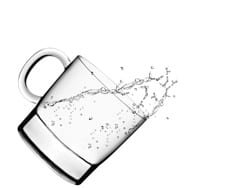According to a recent report on drinking water taken in the United Kingdom, scientists have discovered traces of cocaine in the water, even after it has undergone an intensive series of purification treatments. The compound that was found contained benzoylecgonine, which is what cocaine turns into after it has been metabolized by the body. In fact, it is the same chemical that is targeted in urine-based drug tests for cocaine use.
Steve Rolles, a spokesperson from Transform, a drug policy think tank, shared with The Sunday Times of London that his findings were significant. If this is any indication of the scale of cocaine use in Great Britain today, then “we have the near highest level of cocaine use in western Europe.” As the drug has become less and less expensive, its use has been on the rise. A charity called “DrugScope” said that their independent study indicates about 180,000 dependent crack cocaine users in England and nearly 700,000 people between the ages of 16 and 59 are estimated to use cocaine every year in Britain.
In addition to the primary compound of metabolized cocaine (benzoylecgonine), researchers also found trace amounts of ibuprofen, as well as an epilepsy drug, carbamazepine. Britain’s drinking water also tested high for caffeine.
Assessing the risk from pharmaceuticals appearing in the nation’s water supply, a recent report from PHE (Public Health England) found that the quantities of cocaine found were around a quarter of what appeared before treatment and, at a dose of just 4 nanograms per liter, was unlikely to represent a danger to the public.
Fortunately, Rolles also explains that the estimated exposure of these detected amounts of cocaine in public drinking water are still thousands of times lower than what has been known to cause adverse effects in animals and people.
What can be done to filter your water at home?
There is little argument that municipal tap water has a fair share of questionable contents, which has led millions of Americans to switch the water they use for drinking and cooking to more trustworthy filtered water. However, buying bulk quantities of bottled water can be expensive and inconvenient. As a result, the option to use a filtered water delivery service has quickly taken off. Easier still is the ability to filter tap water in the home using an advanced water filtration system.
With our increasingly hectic schedules these days, many families are seeking a more permanent solution to in-home water filtration; one that provides efficiencies in cost and convenience without sacrificing quality. For your Colorado home, reverse osmosis systems are the cutting edge water filtration systems that provide clean, great tasting water for all your cooking and drinking needs!
What other contaminants are found in municipal tap water?
Perchlorate: Imagine how this would impact your health – an explosive element that is often used to make rocket and missile fuel! This chemical doesn’t sound like something one might want to drink, but because we lack federal regulations it is present in the drinking water of more than 20 million Americans.
Radium: Most of the radium found in drinking water can be removed through purification techniques like ion exchange, but trace amounts still remain and can be harmful over time. Studies have linked long-term radium exposure to significantly higher rates of liver, bone and breast cancer.
THMs and HAAs: Despite measures that require water treatment facilities to report byproduct levels of chlorine, as well as the EPA’s DBP Rule regulating stage 2 disinfectants and their byproducts, there have been several documented cases of water contaminated by THM and HAA. These dangerous contaminants have been shown to cause cancer of the bladder, rectum, colon and breast.
Arsenic: This dangerous chemical can come from a variety of sources, but because of its lack of taste and odor it is often very difficult to detect. A harmless appearance, however, belies the fact that this is not a safe element to ingest. In fact, prolonged exposure to arsenic has been shown to accelerate the incidence of Type II Diabetes, as well as liver, lung and lymphatic cancers.





